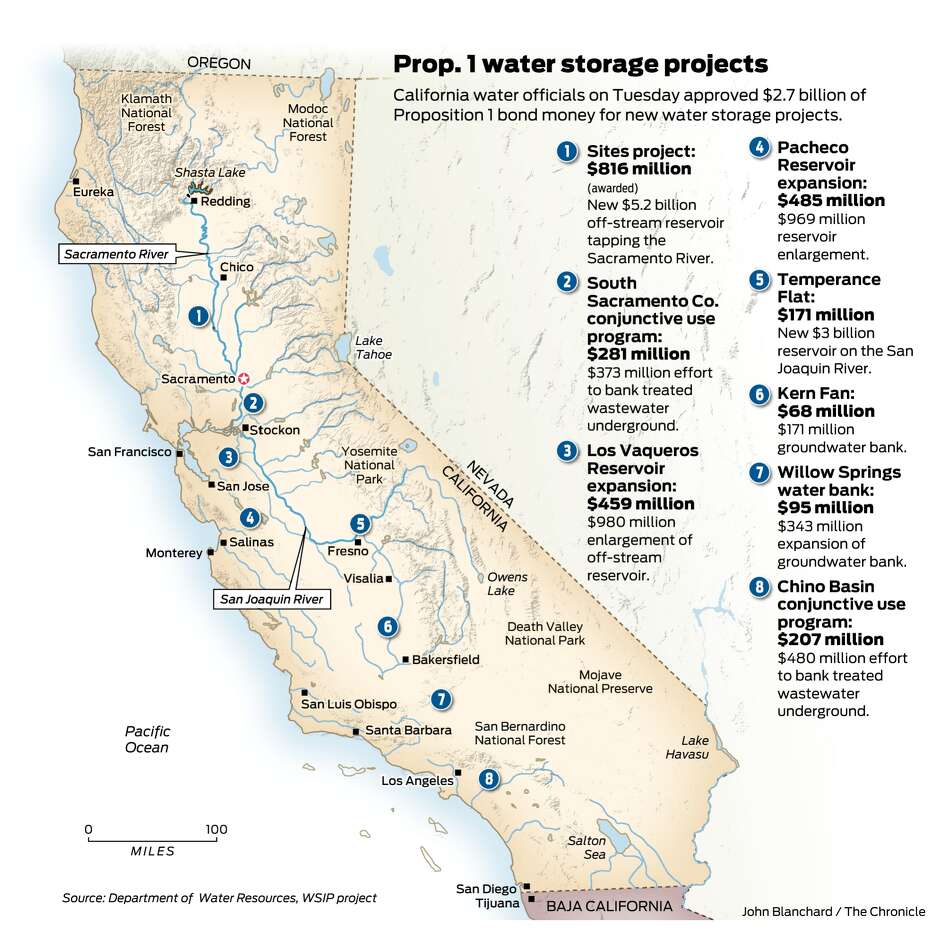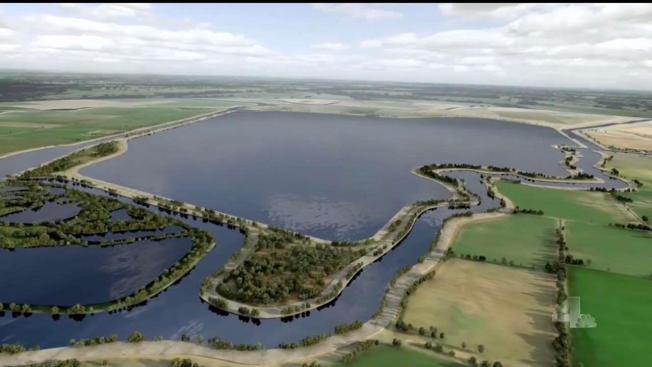- Joined
- Dec 6, 2010
- Messages
- 33,424
- Reaction score
- 5,686
Water wars head upstream as state considers cutbacks for senior Central Valley irrigation districts
By Bettina Boxall | Jul 23, 2018

Steve Ritchie, an assistant general manager at the San Francisco Public Utilities Commission, walks on a bridge over Moccasin Reservoir on the Tuolumne River in 2014.
By Bettina Boxall | Jul 23, 2018
Steve Ritchie, an assistant general manager at the San Francisco Public Utilities Commission, walks on a bridge over Moccasin Reservoir on the Tuolumne River in 2014.
More than two decades after Los Angeles was forced to cut water diversions to protect California’s natural resources, the state is poised to impose similar restrictions on San Francisco and some of the Central Valley’s oldest irrigation districts.
The proposal represents a dramatic new front in one of California’s most enduring water fights: the battle over the pastoral delta that is part of the West Coast’s largest estuary and also an important source of water for much of the state.
Regulators have long focused on the harmful environmental effects of the Sacramento-San Joaquin delta’s giant pumping operations, which send water south and have helped push native fish to the brink of extinction. As fish populations collapsed, environmental limits on water exports to San Joaquin Valley farms and Southern California cities have tightened.
Now, the State Water Resources Control Board is looking upstream to agricultural districts and cities that have long escaped responsibility for the delta’s woes — even though they suck massive quantities of water out of the river systems that feed the delta.
“It’s an important milestone,” board chairwoman Felicia Marcus said. “We’ve laid out a framework … for taking the next step in reconciling ourselves with the natural world in a way that has been on the plate for decades.”
In what environmentalists say is a long overdue move, the board for the first time is asking major upstream diverters to take less from three heavily tapped tributaries of the San Joaquin River, which merges with the Sacramento River to form the delta, a maze of farm islands and meandering water channels.
More water in the Stanislaus, Tuolumne and Merced rivers will improve conditions for migrating salmon, the board says, increase flows in the much abused lower San Joaquin River and ultimately boost inflow to the delta.
But more water for the delta and salmon means less for San Francisco and the agricultural districts that staked their claims to river flows a century or more ago.
“What gives is going to be a cutback in farming,” said Scott Furgerson, general manager of the 131-year-old Modesto Irrigation District, which has historic rights to the Tuolumne. “We’re going down a slippery slope.”
The Modesto, Oakdale, South San Joaquin, Turlock and other districts take so much water out of the three salmon rivers that average flows on the tributaries range from 21% to 40% of what they would be without dams and diversions. At times the riverbeds hold as little as 10% of their natural flow.
Dams, diversions, pollution and shrinking habitat have driven California’s fabled salmon runs onto the endangered species list, triggering environmental lawsuits and efforts to restore some of the water lost to croplands and cities.
The state board proposal would require maintenance of 40% of the natural flow, within a range of 30% to 50%, in the Stanislaus, Tuolumne and Merced during the February-though-June period, which is critical for salmon survival.
That would collectively cost water users 300,000 acre-feet of supply — or about 15% of their total diversions on all three rivers. (An acre-foot is enough to supply two average households for a year.)
But that could change. The board says less flow might be required if districts agree to measures to improve conditions for salmon, which swim up the tributaries to spawn.
“We’re extending an olive branch to say if you come up with a better idea, we’ll reward it,” Marcus said.

The board has spent years developing the flow standards. It released a draft of the proposal in 2016, when Gov. Jerry Brown called for voluntary agreements between the state and water districts to avoid a contentious rule-making process.
The state hired former U.S. Interior Secretary Bruce Babbitt to help with the negotiations. But the off-and-on talks have yet to yield a settlement.
State officials hope this month’s release of the final board plan will kickstart discussions.
“We’re really hoping that we can keep the water users at the table as a result of these documents coming out and see if we can come to closure on agreement that we can present to the water board,” said Karla Nemeth, director of the state Department of Water Resources. “Everybody’s going to need to give a little.”
In place of water cutbacks, San Francisco and the other major diverters have proposed restoration efforts such as rebuilding gravel beds for spawning, control of salmon predators and creation of floodplain habitat.
“We think the state board uses a very simplistic approach,” said Steve Ritchie, an assistant general manager at the San Francisco Public Utilities Commission, which gets which gets most of its supply from Hetch Hetchy Reservoir on the upper Tuolumne.
He warned that the flow requirements would leave San Francisco and the Bay Area communities it serves with less water reserves to ride out droughts. “We just wouldn’t be able to replenish our storage over time,” Ritchie said.
On the Stanislaus, the 40% flow standard “is surely not anything we will accept,” said Steve Knell, general manager of the Oakdale Irrigation District, which has made roughly $40 million in the past decade selling some of its river supplies to less water-rich agricultural districts.
Environmental advocates also don’t like the proposed requirements, which they deem too low in the overtaxed San Joaquin system.
“The science is pretty strong,” said Gary Bobker, program director for the Bay Institute, an estuary protection group. “If you want to have anywhere from stabilizing fish populations to actually recovering them and rebuilding the stock to a healthy level, you’ve got to have somewhere between 50 and 60% of the [natural] runoff.”
He added that “you can’t separate flow” from all the other factors — such as invasive species and poor water quality — that contributed to the steep decline of California’s salmon stocks, which were once so abundant that farmers scooped the fish out of rivers and fed them to hogs.
Bobker nonetheless credited the board for extending the pain of water cuts to the most senior agricultural diverters — something the panel of gubernatorial appointees has historically been reluctant to do.
“We’re moving to a mentality where we’re all in this together as Californians,” he said.
Indeed, the board is not stopping in the San Joaquin Valley. It is also developing flow requirements for the Sacramento River basin that would cut diversions in that watershed and send more water to the delta.
And the board wants to increase flows through the delta and out to sea to restore some of the estuary’s natural hydrological rhythm. That could mean less water is pumped south.
“It may take a while. We might have to litigate a while but … I’m very confident we’ll succeed,” Marcus said.
She citied the Mono Lake case, when the board in 1994 ordered Los Angeles to reduce diversions from the Eastern Sierra to protect the region’s fish and wildlife. To compensate, the city has stepped up development of local supplies, purchased more imported water from the Colorado River and Northern California and promoted conservation. Despite adding 1 million residents, L.A. is using less water than it did two decades ago.
No matter how senior, water-use rights do not confer ownership, Marcus notes.
“Water belongs to all the people of the state of California,” she said. “And fish and wildlife are one of those commonly held assets that we as a water board are supposed to be protecting.”
Last edited:





